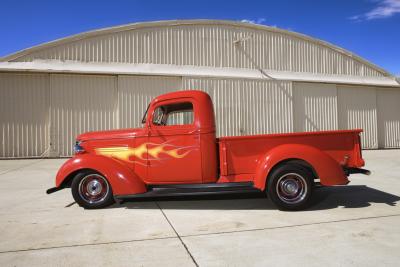
Painting your truck can be either really cheap or very expensive. Much of it depends on your own tastes and preferences. Clearly, taking your vehicle to a professional painter is going to run a couple thousands of dollars by the time all the work is done. It will look brand new, as if delivered from the factory, but your truck will definitely cost a pretty penny under a professional option. That said, if you just need to recoat your truck to protect it, there are cheaper methods to accomplish that task.
If you’re going to do the job yourself, then you will need to spend some time and a few dollars doing prep work. At a minimum, you will need to sand down any rusted areas. The rest of the vehicle will need to be scrubbed clean. You won’t need to remove any parts for a simple rattle-can job, but you will need to tape off various areas that you don’t want painted (i.e. windows, handles, wheels, mirrors, etc.).
You may also need to bondo (filler) and sand or smooth-out areas that need to be filled, before you can paint smooth surface on areas that have been dented.
If you’re taking the vehicle in for a basic paid spray job, the painter will do most of the taping for you, but you will still need to clean the vehicle and get rid of the rusted areas. Otherwise, the painter will charge you for the extra work involved.
The cheapest paint job is the do-it-yourself with a spray paint can. For a decent job, you will need both a primer and paint and then a clear top coat. Gray primer is best, as it will cover up the old paint and give you a surface that the new paint will adhere to. A good base will take multiple coats of color paint to come through thick. That said, you don’t want to paint too much in one spot, or it will liquefy and drip. Cost ranges from $3 to $6 per paint can, depending which brand you use. When finally done with coats, you will need a clear top coat to give color and protective surface. You could go without it, but eventually the color will dull and scratch, without a clear top coat to protect it.
Doing a rattle-can approach will require you to have your own painting area. Whether it’s your garage or a rented location, you will need to protect yourself and others from overspray. You will also need to deal with cleanup after the painting, since spray paint gets just about everywhere when in a gas state.
The first step to having someone else do your paint job is the common spray booth business approach. For a few hundred dollars, they can take your old truck, tape it up, roll it into a spray booth and paint over your old truck paint. Using this approach, you get what you pay for; the paint job goes right over your old paint and you will see detail sloppiness where the tape ended. But if you just need a basic re-coat, this approach is far better than the rattle-can, and you don’t have to deal with the mess yourself.
The process of powdercoating is very similar to that used in regular car factories today. That said, powdercoating is permanent, and has to be managed by certified powdercoat paint businesses. It is not a do-it-yourself process. Rather than being sprayed on, the paint is cooked on with heat at high temperatures. This means that all the metal parts have to be stripped of any plastic or items that will melt. The paint is then electrically charged onto the bare metal and cooked. The paint layer goes on very thick, as well. The final product is a professional-looking paint that is very durable and doesn’t chip easily at all. Cost is variable, depending on how much you want painted. All body parts have to be separated from the car and sanded down to bare metal prior to painting.
For a basic, cheap truck painting, going with a spray booth operation is probably the best solution for a complete re-coating. If your truck just needs a spot painting and you’re not too worried about it looking perfect, you can go the rattle-can approach, which will save you money. Remember, don’t paint when it’s cold; the paint won’t adhere well, and it will have a wrinkling or pasty effect when dried.